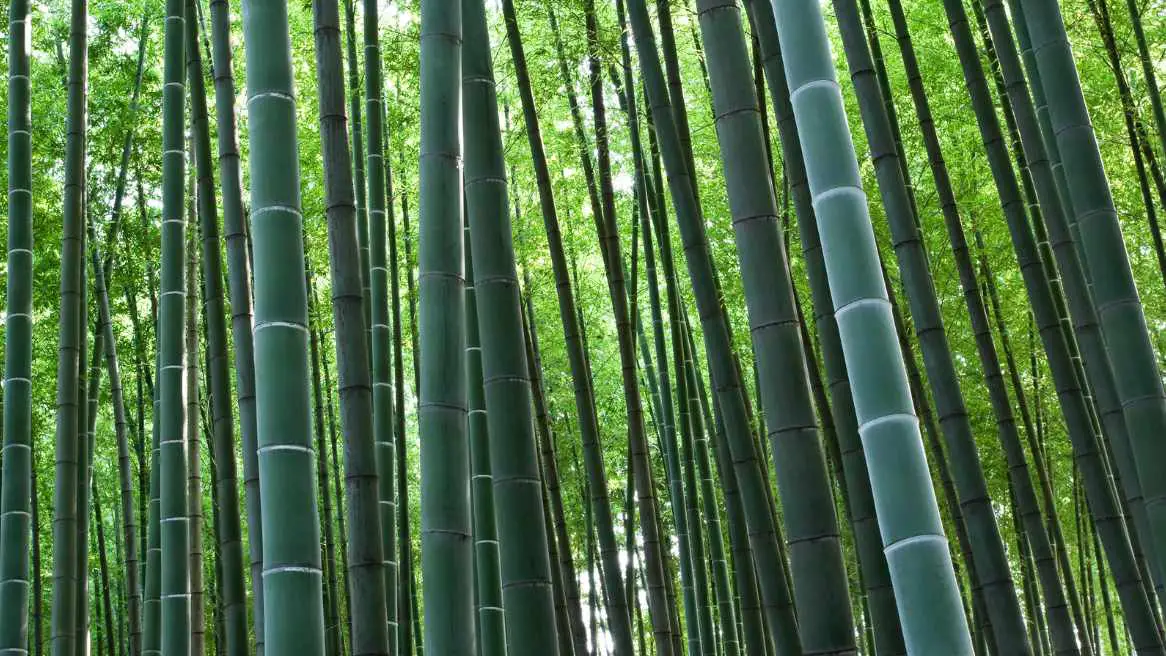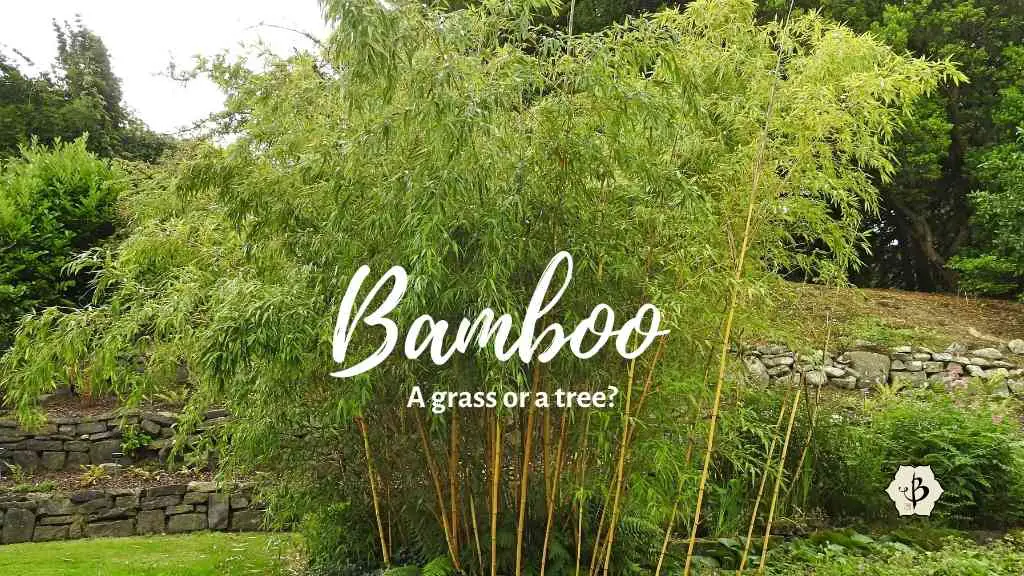“I think that I shall never see a poem as lovely as a tree,” said the American poet Joyce Kilmer. Oak, spruce, or redwood, a tree is a most wonderful thing to behold, tall, mighty, and teeming with greenery. You probably wouldn’t speak as glowingly about a patch of grass. But some grasses are equally if not more majestic than a tree. Of course, I’m talking about bamboo.
Many people think of bamboo as a most unusual tree, but in fact, it is a grass. The roughly 1,500 species of bamboo all belong to the grass family, Poaceae, in the subfamily Bambusoideae. Unlike trees, which have a single trunk that grows year after year, bamboo and other grasses form clumps or patches, producing a fresh wave of new culms every growing season. Moreover, when a bamboo pole is cut down to the ground, the plant lives on in its roots, and it will continue to spawn new shoots with unstoppable tenacity.
Common confusion: Grasses and trees
Gazing up a 50 or 60-foot tall bamboo culm, with its high branches and their profusion of delicate leafage, it’s natural to think of it as a tree. And if you should cut the bamboo down, you’ll find that it is particularly hard and woody, much like a tree. The main difference you’ll notice is that the bamboo (in most cases) is hollow inside.
But bamboo is not a hollow tree. Rather, it is a woody grass. At least, the bamboo varieties we are most familiar with are woody. There’s actually a whole category of herbaceous, or non-woody bamboos, classified in the Olyraea tribe. And you would never confuse these shrubby bamboos with trees. There are also dozens of diminutive bamboo varieties that we refer to as dwarf bamboo, that bear no resemblance to a tree.
Still, when you see floors, cutting boards and cabinetry made from bamboo lumber, it’s natural to think that you’re looking at a tree product. Indeed, any product that can be made from a tree — from charcoal to building material — can be made equally well but more renewably from bamboo. And yet, it is definitely a grass.
Bamboo taxonomy: The grass family
Botanical classifications are not always obvious and straightforward. Plants and trees are products of nature, while the categories and systems of classification we use are strictly manmade. It’s easier for us to cope with nature’s vast diversity when we are able to compartmentalize it. But Mother Nature’s wondrous ways all too often defy our tidy labels and boxes.
The difference between a tree and a shrub can be somewhat ambiguous. However, the line between trees and grasses is actually pretty clear. And when you take a close look at the morphology of bamboo, you’ll quickly see why it belongs to the grass family.

Bamboo morphology
The key distinguishing characteristic of grasses, at least for botanists, is that they are monocotyledons, rather than dicotyledons. That means they have only one embryonic leaf, unlike other flowering plants which have two. In other words, when the plant first emerges from its seed, you’ll see just a single blade of grass. Other plants and trees sprout a stem with two symmetrical leaves.
In the case of grasses, the stem is called a culm. It could be soft or woody, and it’s almost always hollow. Sometimes we call the culm a stalk or a cane. The culms typically have nodes, or joints, where leaves or branches form, usually on alternating sides along the stem.
Grassy growth habits
While there are a number of common traits, the grass family is extremely diverse. Many grasses are annual plants. These include the grains, like corn, rice, wheat, and barley, which come up in the spring, grow and flower over the summer, go to seed, and then die off in the fall. Generally, we harvest them in the fall and gather the seeds, i.e. the grains.
Other grasses, like bamboo, are perennial. They continue to grow year after year. Eventually bamboo will flower, but it could take as long as a century or more before that happens. At that point, the plant will usually die back, but not always.
Although bamboo keeps growing, it does not continue to grow the way that trees and other dicotyledons do. Each year, a tree adds another layer of wood to its trunk. That’s why you can count the rings to know its age. But that’s not the case with bamboo and other grasses.
A bamboo shoot emerges at the beginning of the growing season, usually in spring, and it will grow vigorously throughout the season. Then it reaches its full height. That could be 10 feet, or it could be 100, depending mostly on the species. In the following year, that culm will not get any taller. The stem will harden, to give the wood a higher quality. It will also make more lateral branches and leaves, and the plant will go on to produce new shoots.
The life of the perennial grass really resides in the roots. You can cut down the culms, or mow your lawn, and the fresh growth will come up quickly. This pruning or harvesting actually stimulates the plant and encourages the roots system to generate more grass. Grass that doesn’t get mown tends to languish, and the same is true of bamboo. If you leave all the canes in the ground, they will eventually start to age and decay.
Timber bamboo: Taller than trees
These characteristics are basically true for all types of bamboo. Although some species have stems that are solid or almost solid. And some have stems that are softer and less woody. But some varieties of bamboo definitely look more like trees than others.
Timber bamboo is a non-scientific category of bamboo that grows more than about 40 or 50 feet tall. These bamboo varieties tend to have little or no foliage on the bottom halves of the culms, giving the appearance of tall, elegant trunks. The wood from these bamboo species also tends to be the highest quality and best for making building material. Such products are an excellent alternative to conventional lumber which comes from trees that take much longer to replace.
Running bamboo has a way of spreading out and forming a grove that bears the most resemblance to a forest. These species are more common in temperate climates, including most of China and the US.
- Moso bamboo (Phyllostachys edulis): Native to China, very economically important.
- Giant gray bamboo (Phyllostachys nigra ‘Henon’): Commonly grown in the US Southeast.
- Japanese timber bamboo (Phyllostachys bambusoides): Cold-tolerant timber bamboo popular on the West Coast.

The largest timber bamboo species are tropical, clumping varieties. They tend to grow in dense thickets that look less like trees or forests. But their size is formidable.
- Dendrocalamus giganteus: This giant tropical bamboo and other members of the genus often grow more than 100 feet tall, with culms up to a foot in diameter.
- Guadua angustifolia: The most important bamboo species in Colombia and Ecuador, an open clumper that spreads out more loosely than most species of Dendrocalamus.
- Bambusa oldhamii: A subtropical species commonly grown as an ornamental in California and other southern states with mild climates.
Bamboo literature to leaf through
If you’re fascinated by bamboo and its unique place in the plant kingdom, you may want to peruse our website and check out some of our other interesting articles.

























